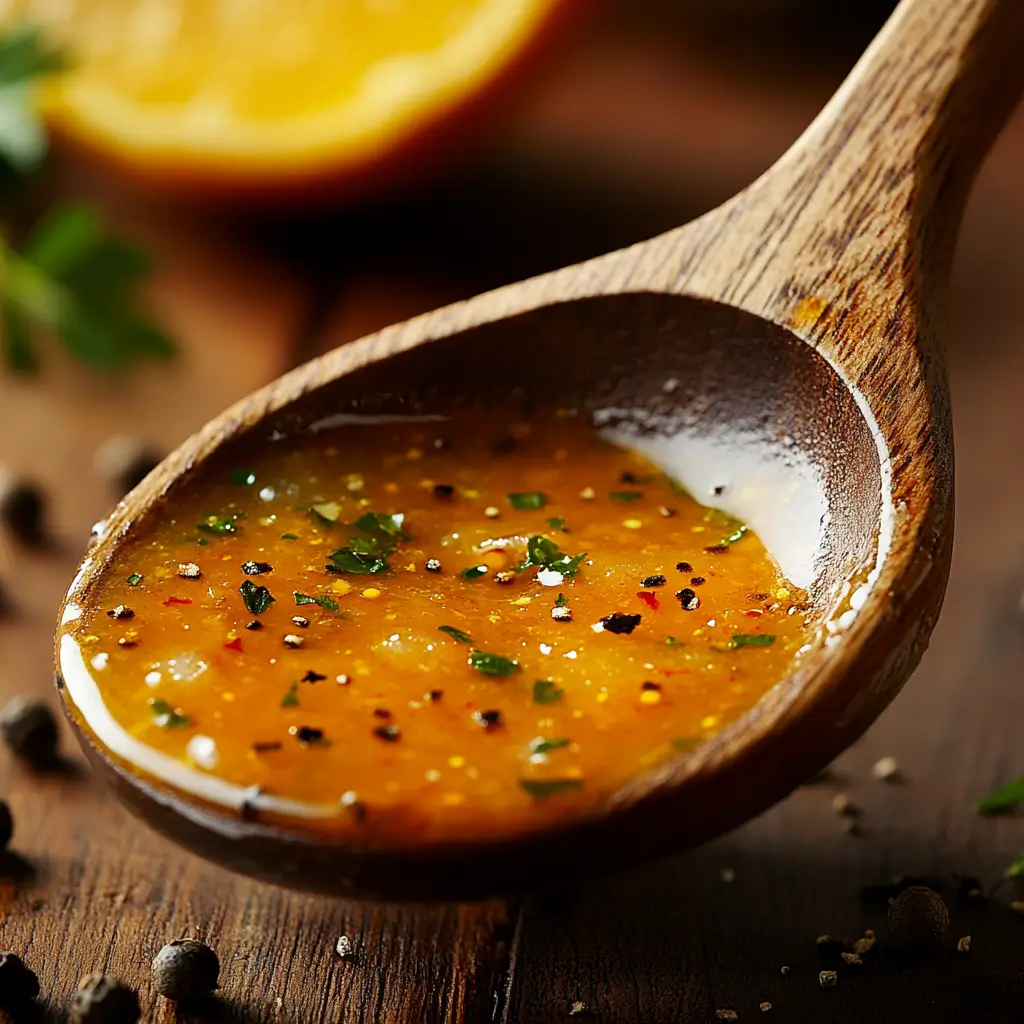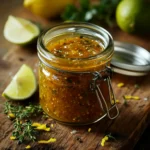Caribbean Lime & Lemon Pepper Sauce delivers more than just heat or tang—it brings sunshine to your plate. As a matter of fact, this bold tropical citrus sauce embodies the spirit of Caribbean cuisine with its vibrant mix of lime, lemon zest, and cracked black pepper. At the same time, it pairs well with grilled meats, seafood, roasted vegetables, and even salad dressings.
As I have shown in the outline, this article guides you step-by-step through making the [Caribbean Lime & Lemon Pepper Sauce] from scratch. In addition, you’ll learn how to adjust its thickness, vary the flavors, and use it in countless creative ways. Because this recipe is incredibly versatile and quick to prepare, it deserves a permanent place in your cooking rotation. Above all, it’s customizable—perfect for food lovers of all skill levels.
Moreover, if you’re a fan of bright, bold flavors and island-inspired cooking, you’re in the right place. Read on to learn exactly how to master this tangy island pepper mix in your own kitchen.

How to Make Caribbean Lime & Lemon Pepper Sauce from Scratch
Unlike store-bought options, homemade [Caribbean Lime & Lemon Pepper Sauce] allows you to control every ingredient. As a result, you can tweak the citrus, spice, or salt to suit your taste preferences. In fact, this flexibility makes it perfect for weeknight dinners, cookouts, or special occasions.
Generally, most of the ingredients are pantry staples. For example, lime juice, black pepper, garlic, and olive oil are likely already in your kitchen. On the other hand, ingredients like fresh thyme and scotch bonnet peppers give the sauce its island personality. Likewise, if you can’t find those items, we’ll offer substitutes in later sections.
Additionally, the preparation process takes less than 10 minutes. Even if you’re short on time, you can whip up a batch without hassle. Because of this, many home cooks prefer to make small batches frequently for freshness.
Ingredients Table
| Ingredient | Amount | Notes |
|---|---|---|
| Fresh lime juice | ¼ cup | Use key limes for deeper flavor |
| Lemon zest | 1 tbsp | Organic lemons reduce bitterness |
| Black pepper (cracked) | 2 tsp | Freshly cracked for best aroma |
| Garlic (minced) | 2 cloves | Optional but adds savoriness |
| Olive oil | 2 tbsp | Acts as an emulsifier |
| Fresh thyme | 1 tsp | Can use ½ tsp dried thyme |
| Scotch bonnet pepper | ½ pepper | Add more or less for heat level |
| Sea salt | To taste | Enhances flavor complexity |

Step-by-Step Instructions
Firstly, gather and prep your ingredients. Juice your limes and zest the lemon using a microplane. Then, crush the black pepper if you haven’t already. Meanwhile, chop the garlic and thyme finely for even blending.
Next, place all ingredients into a blender or food processor. Blend using short pulses, just until the mixture becomes cohesive. Because this sauce shines with texture, avoid pureeing until smooth. A slightly chunky texture gives it body and visual appeal.
After blending, pour the sauce into a glass jar or bottle. At this point, let it sit for 30 minutes to allow the flavors to meld. During this rest period, the citrus infuses the oil, and the pepper and herbs soften slightly. Consequently, the flavor becomes rounder and more balanced.
Although the sauce is ready to use right away, refrigeration enhances its depth. Ideally, chill it for at least an hour before serving. Importantly, always give it a shake or stir before using, as natural separation may occur.
Print
Caribbean Lime & Lemon Pepper Sauce: Bold Flavor in Every Drop
- Total Time: 10 minutes
- Yield: Approximately ¾ cup of sauce
Description
This vibrant Caribbean Lime & Lemon Pepper Sauce is zesty, peppery, and bursting with island flavor. Made with fresh lime juice, lemon zest, cracked black pepper, and the fiery kick of scotch bonnet pepper, it’s the perfect condiment for grilled meats, seafood, and roasted vegetables. Unlike store-bought versions, this homemade sauce lets you control the heat, salt, and citrus balance—ideal for weeknight meals or festive gatherings.
Ingredients
¼ cup fresh lime juice (use key limes for deeper flavor)
1 tbsp lemon zest (organic lemons recommended)
2 tsp freshly cracked black pepper
2 cloves garlic, minced (optional for savoriness)
2 tbsp olive oil
1 tsp fresh thyme (or ½ tsp dried thyme)
½ scotch bonnet pepper (adjust to heat preference)
Sea salt, to taste
Instructions
Gather all ingredients. Juice the limes, zest the lemon, and crack the black pepper. Mince garlic and thyme finely.
Add all ingredients to a blender or food processor.
Pulse blend until the mixture is cohesive but slightly chunky—avoid over-blending.
Transfer the sauce to a glass jar or bottle.
Let it sit for 30 minutes at room temperature to allow the flavors to meld.
For enhanced depth, refrigerate for at least 1 hour before using.
Shake or stir before serving. Store leftovers in the refrigerator for up to 1 week.
Notes
For a milder sauce, remove the seeds from the scotch bonnet or substitute with a milder chili like jalapeño.
You can swap olive oil with avocado oil for a more neutral flavor.
Use as a marinade, finishing drizzle, or dipping sauce. It pairs beautifully with grilled shrimp, roast chicken, or roasted sweet potatoes.
- Prep Time: 10 minutes
- Cook Time: 0 minutes
- Category: Sauce & Dressings
- Cuisine: Caribbean
Nutrition
- Calories: 40
- Fat: 4g
- Carbohydrates: 1g
- Protein: 0g
Keywords: Caribbean Lime & Lemon Pepper Sauce
Regional Variations of the Caribbean Lime & Lemon Pepper Sauce
Since this recipe originates from the Caribbean, it’s no surprise that each island puts its own twist on it. Generally, spice levels, herb choices, and even citrus types vary based on location and culture. As an illustration, in Trinidad, cooks often include culantro (a stronger cousin of cilantro), while in Jamaica, allspice might make a surprise appearance.
Additionally, sauces from the Bahamas lean toward sweeter profiles, occasionally including a splash of orange juice. Therefore, don’t hesitate to try your own regional spin, especially if you’re aiming to replicate a dish you had on vacation or in a favorite restaurant.
Add Mango for Sweet and Spicy Fusion
Interestingly, ripe mango adds not only sweetness but also thickness and aroma. For example, blend ½ a mango into your sauce to tame the heat while boosting the tropical vibe. As a result, it becomes an ideal dip for fried plantains or grilled fish tacos.
Alternatively, pineapple chunks or passionfruit pulp can offer similar sweetness. For a sweeter balance, use 1 tablespoon of honey instead, especially if fresh fruit isn’t on hand.
Spice Levels and Scotch Bonnet Tips
Although scotch bonnet peppers are traditional, they can be intensely hot. Because of this, always wear gloves while handling them. Additionally, remove the seeds and white membrane to reduce their fire.
Alternatively, substitute habanero peppers or serrano chilis for a more accessible heat level. Nevertheless, these substitutes won’t replicate the fruity aroma of the scotch bonnet, so balance with extra lime or even a hint of sugar to round it out.
How to Thicken Caribbean Lime & Lemon Pepper Sauce
Because this sauce contains both citrus and oil, achieving the right thickness takes a bit of finesse. Luckily, there are several methods that don’t compromise flavor. Each thickening approach serves a slightly different use case, whether you’re drizzling over veggies or spooning it onto grilled steak.
Use Xanthan Gum for Quick Fixes
If you’re short on time, add ⅛ teaspoon of xanthan gum while blending. Accordingly, it thickens the sauce instantly without cooking or altering the taste. This method works well for meal preps and catering, where texture consistency matters most.
Moreover, xanthan gum is gluten-free and doesn’t change the sauce’s vibrant appearance. Therefore, it’s ideal for dietary-sensitive cooking.
Simmer to Reduce and Intensify
On the other hand, the reduction method involves slowly simmering the sauce in a non-stick pan. Stir continuously until it thickens by about 20%. This process also deepens flavor by concentrating the citrus and herbs.
However, avoid boiling. High heat can dull the lemon zest and turn the lime juice bitter. Instead, use medium-low heat and taste as you go. Accordingly, this method is perfect when you want a richer, glaze-like texture.
Natural Thickeners: Avocado, Mango, or Yogurt
Adding half an avocado not only thickens but also creates a creamy consistency that’s great for dipping. Furthermore, mango not only sweetens but thickens due to its fibrous texture.
Conversely, if you want a tangy and creamy profile, whisk in 2 tablespoons of Greek yogurt. This variation works well as a zesty sandwich spread or as a dip for grilled skewers.
Ingredient Substitutions and Recipe Flexibility
Because accessibility is important, let’s cover some substitutions for hard-to-find ingredients. After all, flexibility makes this recipe appealing to home cooks across the U.S. and beyond.
- Lime juice: If fresh limes aren’t available, use bottled—but check that it’s 100% juice without additives.
- Scotch bonnet: Replace with habanero, serrano, or even red chili flakes. However, adjust quantity accordingly.
- Fresh thyme: Use dried thyme (½ tsp) or substitute with oregano for a slightly different profile.
- Olive oil: Avocado or grapeseed oils work well for a neutral base.
Above all, don’t skip the citrus elements. The lime and lemon are non-negotiable—they define the bright, tangy core of the [Caribbean Lime & Lemon Pepper Sauce].
For more creative and adaptable sauce ideas, explore the creamy roasted red pepper sauce. It showcases a similarly bold, emulsified structure perfect for blending textures. Similarly, the green taco sauce demonstrates how herbs and acid create vibrant, versatile condiments you can customize endlessly.
How to Store and Reuse Your Sauce
To preserve freshness, store the finished sauce in a clean, airtight glass jar. Because olive oil can solidify in the fridge, let the sauce sit at room temperature for 10 minutes before using. Stir gently to re-emulsify the layers if separation occurs.
Generally, the sauce lasts 5–7 days when refrigerated. For longer storage, freeze in ice cube trays and defrost portions as needed. However, freezing may slightly alter the texture, though the taste remains bold and vibrant.
Use leftover sauce in salad dressings, pasta, grilled cheese sandwiches, or as a marinade for tofu. The possibilities are endless when the base flavor is this powerful and fresh.
Creative Ways to Use Caribbean Lime & Lemon Pepper Sauce
Following the basics of how to prepare Caribbean Lime & Lemon Pepper Sauce, it’s important to understand how versatile it truly is in the kitchen. Because this sauce blends bright citrus with bold spices, it elevates everything from proteins to vegetables and even snacks. Therefore, learning multiple ways to use it ensures you always find a flavorful solution to your meal planning needs.
Firstly, use it as a zesty marinade. Mix the sauce with yogurt for a creamy base, or simply apply it as-is to chicken, shrimp, or tofu. As an illustration, marinating boneless chicken thighs in the sauce for four hours yields incredibly juicy results, especially when grilled over high heat. Meanwhile, tofu cubes absorb the tanginess beautifully when left overnight, offering a plant-based option that doesn’t skimp on flavor.
Additionally, the sauce shines when paired with roasted vegetables. Toss sweet potatoes, carrots, or cauliflower in a few spoonfuls of the sauce before baking. Consequently, the natural sugars in the veggies caramelize under the citrus and spice. This combination creates a flavorful contrast that’s both sweet and savory. For instance, roasted cauliflower florets with a final drizzle of this sauce become a stunning appetizer or side dish.
Another great use for the sauce is as a base for sandwich spreads. Mix it with mayo, hummus, or Greek yogurt. Then, slather it on wraps or toast before layering with proteins or grilled vegetables. It’s a simple upgrade with a big flavor payoff.
Interestingly, some home cooks even stir the sauce into pasta salads or rice bowls. In this case, the citrus cuts through heavier ingredients like cheese or cream-based dressings. As a result, each bite remains fresh and balanced.
Pro Tips & Variations for Caribbean Lime & Lemon Pepper Sauce
Because this sauce adapts easily to different dietary needs and cuisines, consider tweaking it for variety. For example, if you’re reducing oil in your diet, substitute half the olive oil with water or coconut water. This method retains flavor while lightening the texture. Alternatively, for more tropical depth, use coconut oil instead. It pairs well with grilled pineapple or jerk-seasoned dishes.
Also, don’t overlook fresh herbs beyond thyme. While thyme is classic, basil or cilantro introduce a new dimension. If using cilantro, add lime zest to highlight its citrus-like qualities. For a bolder flavor, try Caribbean all-purpose seasoning. This mix often contains garlic powder, paprika, and ginger, which all complement the core ingredients.
Equally important, the sauce can be turned into a glaze. Simply simmer it with a bit of honey or agave syrup until slightly thick. Then, brush it onto meats or tofu during the last few minutes of cooking. This caramelization creates a sweet-spicy crust that’s packed with flavor.
For a sweet and tangy variation, blend in mango or pineapple. Both fruits not only thicken the sauce but also balance the citrus sharpness. As an illustration, pineapple puree adds tropical sweetness that makes the sauce kid-friendly and ideal for grilled kabobs.
As you explore more ways to customize your Caribbean Lime & Lemon Pepper Sauce, check out the vegan teriyaki sauce recipe. It uses similar umami-building techniques that pair surprisingly well when layered together in fusion dishes. You can even serve both as dipping sauces for appetizers to offer your guests a flavor contrast.
Likewise, if you’re aiming for deeper flavor complexity, study the techniques used in the birria taco sauce. Although it’s from a different culinary tradition, its approach to layering heat, acid, and depth can be adapted to this Caribbean citrus blend. Both sauces share an appreciation for bold, vibrant ingredients and slow flavor development.
FAQs: Caribbean Lime & Lemon Pepper Sauce
How to make Caribbean Lime & Lemon Pepper Sauce from scratch?
To make the sauce, blend lime juice, lemon zest, cracked pepper, minced garlic, olive oil, and herbs. Use a blender or food processor and pulse briefly for texture. Then, let the mixture rest for at least 30 minutes before using. For smoother versions, blend longer and strain if needed.
How to thicken Caribbean Lime & Lemon Pepper Sauce?
To thicken the sauce, simmer it gently to reduce liquid or blend in avocado, mango, or Greek yogurt. Alternatively, add a pinch of xanthan gum for immediate thickening. Be cautious not to overdo it, as too much will change the sauce’s character.
How spicy is this sauce supposed to be?
Generally, this sauce ranges from mild to medium-hot, depending on how much scotch bonnet is used. For a balanced flavor, include just a small slice of pepper. Adjust the quantity to suit your spice tolerance.
Can I store Caribbean Lime & Lemon Pepper Sauce?
Yes, store the sauce in an airtight glass jar in the refrigerator for up to seven days. Shake before each use, especially if ingredients settle. For extended storage, freeze in small silicone trays and thaw as needed.
What dishes does this sauce pair best with?
This sauce pairs well with grilled seafood, chicken, roasted vegetables, tacos, grain bowls, and salads. It also enhances sandwiches, wraps, and even deviled eggs. Because it’s so flexible, you’ll find endless uses for it.
Can I freeze this sauce?
Absolutely. Portion the sauce into ice cube trays, freeze, and transfer the cubes into a freezer bag. Thaw in the fridge overnight or in a bowl of warm water. Shake or stir after thawing to recombine the ingredients.
Is this sauce suitable for vegans?
Yes, the basic recipe is vegan-friendly. As long as you avoid dairy-based thickeners, it remains plant-based. Use avocado or mango for creaminess instead of yogurt or mayonnaise.
Can I use this sauce as a marinade?
Definitely. Because of its acidic and oily composition, it’s excellent for marinating proteins. Let meat or tofu sit in the sauce for a few hours before grilling or roasting. This helps tenderize the meat and infuse it with flavor.
Conclusion
Altogether, [Caribbean Lime & Lemon Pepper Sauce] is a culinary gem that adds flair, brightness, and depth to countless dishes. Its combination of citrus, spice, and herbs not only elevates simple meals but also inspires creative cooking. Whether you’re dressing vegetables, glazing meats, or mixing a marinade, this sauce delivers every time.
Because it’s easy to prepare and endlessly customizable, it appeals to cooks of all levels. With the right balance of acid and heat, along with your personal touch, this sauce becomes more than a condiment—it becomes a signature flavor in your kitchen.
